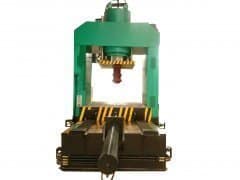Can You Make a Diamond With a Hydraulic Press?
time:2023-09-26 views:(点击 1,038 次)
Diamonds are one of the hardest materials on Earth. But what happens if we put one under a hydraulic press? This channel took on this experiment with a 1.2-carat diamond and crushed it under pressure from an hydraulic press to see what would happen.
A hydraulic press operates by employing Pascal's Law to generate large forces with minimal exerted pressure - similar to how bicycle pumps function.
What is a hydraulic press?
A hydraulic press is a piece of equipment that utilizes hydraulic cylinders to produce force. The press has multiple uses, from pressing metal sheets together and crushing cars to making powders; its powerful mechanisms make this an invaluable piece of machinery capable of breaking even tough materials apart.
One of the greatest advantages of hydraulic presses is their ability to generate massive force with minimal effort, making maintenance and repair simpler, thus decreasing downtime and keeping costs at a minimum. Furthermore, these powerful presses can operate at high speeds without overheating.
For anyone curious to understand how hydraulic presses operate, watch this video from Hydraulic Press Channel. In it they demonstrate how a press can crush a diamond of 1.2 carat weight donated for testing; crushing takes just seconds due to hydraulic press pressure being directly applied onto the stone's cleavage planes.
A hydraulic press operates according to Pascal's principle, which holds that pressure applied to confined fluid is transmitted unaltered throughout its entire system. A typical hydraulic press consists of two connected cylinders; one larger than the other contains the plunger while its smaller cylinder contains constant displacement to reduce volume of plunger for constant pressure production; this pressure from ram is transmitted directly onto plunger, then onto object being crushed for crushing purposes.
An additional advantage of hydraulic presses is their ability to generate full force throughout their stroke, giving greater control of deforming processes and more flexibility than other presses. You can easily adjust ram force, direction speed and release of pressure according to your individual requirements - this versatility makes the hydraulic press invaluable in numerous industrial settings.
What is the hardness of a diamond?
Diamonds are widely known to be one of the hardest substances on Earth, but do they withstand the crushing power of a hydraulic press? The Hydraulic Press Channel has built up quite an audience by crushing everything from bowling balls to non-Newtonian fluid, so it was only fitting they take on nature's most durable gem.
Hydraulic press was easily able to crush the diamond, yet this does not imply that diamonds are impervious to damage; indeed they can be very fragile when hit directly at weak points, which depend on its shape and cut.
Importantly, it should also be remembered that hardness of minerals does not equal toughness, which measures their resistance to deformation or cracking. German geologist Friedrich Mohs developed his Mohs scale of mineral hardness in 1812 in order to classify minerals by their ability to scratch other materials; diamonds rank 10 on this scale which makes them four times harder than corundum (which forms gems such as rubies and sapphires), which falls at number nine, while topaz comes in eighth on this ranking system.
Cubic silicon carbide, with its Mohs hardness of 10, is one of the few gems comparable to diamond in terms of hardness. Unfortunately, however, this material cannot be mined directly and must instead be manufactured via synthetic (lab grown) gems.
Diamonds may be one of the hardest natural substances on Earth, yet they're not indestructible. Even under sufficient force it is possible to crack or chip a diamond; jewelers use special tools to cut and polish them into stunning faceted shapes we find in fancy rings and engagement rings. When struck by something such as a hammer they may shatter into fragments which disassemble its intricate atomic structure and dislodge a piece from it's unique composition.
How much force does it take to crush a diamond?
Diamonds may be one of the hardest materials on Earth, but that doesn't make them indestructible. Under enough force they can be cracked, split and even crushed with something as simple as a hammer!
Cleavage explains this effect. When diamonds form, they do so in such a way as to have weak spots within them known as "cleavage planes", located within its crystal structure. Each diamond has four such planes and hitting one with something hard such as a hammer can break it.
Cleavage lines vary on every diamond depending on its cut, so when purchasing one it is crucial to select an expertly cut diamond. Otherwise you risk getting one with lesser durability that easily chips or cracks under pressure.
To break a diamond, it must be struck at precisely the right spot and angle. Otherwise, its atoms will remain tightly bound together and crack instead of shatter. Steel pieces contain more easily separated ions which allow more effective breakage.
With all this in mind, it is easy to see how a diamond could be crushed with a hammer; yet it also illustrates why diamonds aren't indestructible - they can get lost in nature, be fried by torch-fire or be broken into fragments by hydraulic presses.
Can you make a diamond with a hydraulic press?
Though diamonds are known for their durability, it turns out they can still be broken with enough force. As seen in a YouTube video posted to the Hydraulic Press Channel on YouTube featuring a 1.2-carat diamond crushed with enough pressure from a hydraulic press; even though diamonds rank 10 on Mohs hardness scale can still be broken by applied pressure - even from simple hammers!
The Hydraulic Press Channel has become popularly recognized for their viral videos of people crushing things with hydraulic presses, garnering millions of views in total. Over the years, these videos have featured everything from bowling balls to non-Newtonian fluid. But their latest video may take the cake: an impressive 1.2 carat diamond donated to them from an anonymous donor worth $4,000 is quickly turned to dust by an impressive hydraulic press!
Hydraulic Press Channel videos are often celebrated for their mindless destruction, but this particular one contains an important reminder. Although diamond is the hardest natural material known to man, even it can be broken by objects with greater force - particularly those composed of materials with greater tensile strength than diamond itself. Therefore it is vital that diamond owners invest in insurance to cover potential catastrophe. That way if something does happen to their diamond, replacement options will be readily available should something go amiss.
Link to this article: https://www.ihydraulicpress.com/nsn/4676.html
Hot Articles
-
How to Make a Hydraulic Press With Syringes
Hydraulic presses can be used to crush objects with considerable force. Their hydraulic systems rely on fluid pressure that acts equally across al……
-
How Are Hydraulic Presses Used to Make Ceramics?
Hydraulic presses use Pascal’s principle to generate significant force. They consist of two cylinders – slave and master. A pump (manu……
-
How Much Pressure in a Hydraulic Press?
Hydraulic presses play an integral part of manufacturing. They’re used for shaping, stamping, blanking, piercing, staking, punching and asse……
-
How to Make a Small Hydraulic Press
Have you seen videos on YouTube of hydraulic presses crushing items such as bowling balls or soda cans with immense force? They generate great dea……
-
How to Make a Hydraulic Press Model
Hydraulic presses are versatile machines used to crush or straighten metal with equal force as mechanical levers while taking up half the space. I……
-
How to Make a Hydraulic Press Model
Hydraulic presses use liquid pressure to generate mechanical force and are an indispensable tool in many different industries. From assembly, punchi……
-
How to Make Your Own Hydraulic Juice Press
Home craftsmen create these devices using materials that can withstand great pressure. Car jacks provide them with the force they require from above……
-
How Much Does the Hydraulic Press YouTube Channel Make?
Vuohensilta began his YouTube channel in 2015 and since then has crushed an assortment of objects such as hockey pucks, Lego toys, Nokia 3310 phon……
Latest News
-
How to Make a Hydraulic Forging Press Dies
Forging presses apply large forces to pieces of metal at low pressure, an essential process in manufacturing automobile parts such as nuts, bolts,……
-
How to Make a Small Electric Hydraulic Press
Hydraulic presses employ Pascal’s law, which states that any force exerted upon fluid will produce pressure. They’re ideal for metal f……
-
How Much Is a Hydraulic Press?
Hydraulic presses are versatile machines that can benefit both independent workers and larger manufacturers, as they’re relatively cost-effe……
-
How to Make a Hydraulic Press With Syringes
Hydraulic presses are powerful tools that are useful in many industries, from crushing aluminium cans to making metal parts thinner. As it provide……
-
液压机的工作原理-
液压机按同步发展方式方法又可主要分为:扭轴同步,机液同步,和电液同步.液压机按运动管理方式不同又可具体分为:上动式,下动式。框架液压机为了满足企业连续化生……
-
How to Make a Homemade Hydraulic Press Out of a Jack
Making your own hydraulic press from an old jack can save considerable money. Its effectiveness depends on an accurate unit diagram and quality co……
-
How to Make a Hydraulic Forging Press Dies
Forging is a metalworking technique in which gradual pressure is applied to a die containing metal and squeezed with slow strokes to form desired sh……
-
How to Make Dabs With a Hydraulic Press
Rosin is an easy and safe method of extracting cannabis concentrate, without the use of hazardous or poisonous chemicals. Furthermore, it maintains ……
















































